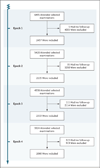Incidence of Dementia over Three Decades in the Framingham Heart Study
- PMID: 26863354
- PMCID: PMC4943081
- DOI: 10.1056/NEJMoa1504327
Incidence of Dementia over Three Decades in the Framingham Heart Study
Abstract
Background: The prevalence of dementia is expected to soar as the average life expectancy increases, but recent estimates suggest that the age-specific incidence of dementia is declining in high-income countries. Temporal trends are best derived through continuous monitoring of a population over a long period with the use of consistent diagnostic criteria. We describe temporal trends in the incidence of dementia over three decades among participants in the Framingham Heart Study.
Methods: Participants in the Framingham Heart Study have been under surveillance for incident dementia since 1975. In this analysis, which included 5205 persons 60 years of age or older, we used Cox proportional-hazards models adjusted for age and sex to determine the 5-year incidence of dementia during each of four epochs. We also explored the interactions between epoch and age, sex, apolipoprotein E ε4 status, and educational level, and we examined the effects of these interactions, as well as the effects of vascular risk factors and cardiovascular disease, on temporal trends.
Results: The 5-year age- and sex-adjusted cumulative hazard rates for dementia were 3.6 per 100 persons during the first epoch (late 1970s and early 1980s), 2.8 per 100 persons during the second epoch (late 1980s and early 1990s), 2.2 per 100 persons during the third epoch (late 1990s and early 2000s), and 2.0 per 100 persons during the fourth epoch (late 2000s and early 2010s). Relative to the incidence during the first epoch, the incidence declined by 22%, 38%, and 44% during the second, third, and fourth epochs, respectively. This risk reduction was observed only among persons who had at least a high school diploma (hazard ratio, 0.77; 95% confidence interval, 0.67 to 0.88). The prevalence of most vascular risk factors (except obesity and diabetes) and the risk of dementia associated with stroke, atrial fibrillation, or heart failure have decreased over time, but none of these trends completely explain the decrease in the incidence of dementia.
Conclusions: Among participants in the Framingham Heart Study, the incidence of dementia has declined over the course of three decades. The factors contributing to this decline have not been completely identified. (Funded by the National Institutes of Health.).
Figures

Comment in
- Dtsch Med Wochenschr. 2016 Apr;141(8):528
-
Incidence of dementia declined in past 30 years in US, study shows.BMJ. 2016 Feb 15;352:i912. doi: 10.1136/bmj.i912. BMJ. 2016. PMID: 26879962 No abstract available.
-
Die Inzidenz der Demenz ist rückläufig.MMW Fortschr Med. 2016 Apr 14;158(7):35. MMW Fortschr Med. 2016. PMID: 27183660 German. No abstract available.
-
Incidence of Dementia over Three Decades in the Framingham Heart Study.N Engl J Med. 2016 Jul 7;375(1):93-4. doi: 10.1056/NEJMc1604823. N Engl J Med. 2016. PMID: 27406362 Free PMC article. No abstract available.
-
Incidence of Dementia over Three Decades in the Framingham Heart Study.N Engl J Med. 2016 Jul 7;375(1):92-3. doi: 10.1056/NEJMc1604823. N Engl J Med. 2016. PMID: 27406363 No abstract available.
-
Incidence of Dementia over Three Decades in the Framingham Heart Study.N Engl J Med. 2016 Jul 7;375(1):93. doi: 10.1056/NEJMc1604823. N Engl J Med. 2016. PMID: 27406364 No abstract available.
References
-
- Prince M, Bryce R, Albanese E, Wimo A, Ribeiro W, Ferri CP. The global prevalence of dementia: a systematic review and metaanalysis. Alzheimers Dement. 2013;9:63–75.e2. - PubMed
Publication types
MeSH terms
Grants and funding
- N01-HC-25195/HC/NHLBI NIH HHS/United States
- R01 NS017950/NS/NINDS NIH HHS/United States
- R01 AG054076/AG/NIA NIH HHS/United States
- HHSN268201500001C/HL/NHLBI NIH HHS/United States
- AG033193/AG/NIA NIH HHS/United States
- R01 AG049607/AG/NIA NIH HHS/United States
- AG08122/AG/NIA NIH HHS/United States
- R01 AG008122/AG/NIA NIH HHS/United States
- HHSN268201500001I/HL/NHLBI NIH HHS/United States
- R01 AG033040/AG/NIA NIH HHS/United States
- U01 AG049505/AG/NIA NIH HHS/United States
- N01 HC025195/HL/NHLBI NIH HHS/United States
- R01 AG033193/AG/NIA NIH HHS/United States
- NS017950/NS/NINDS NIH HHS/United States
- P30 AG010129/AG/NIA NIH HHS/United States
LinkOut - more resources
Full Text Sources
Other Literature Sources
Medical
